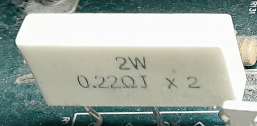I came across an interesting phenomenon today. I was measuring an amplifier distortion at 5W, 1kHz into a dummy load and I noticed that the amplifier itself was emitting a 1kHz tone. My ears aren't great, so if I could hear it, then it must be quite loud. After a bit of experimentation, I determined the sound was actually coming from the dual 2W emitter resistors. If I put my fingers on them to apply some damping, then the sound level dropped considerably. I noted that they are on 'long legs' to give them plenty of air. The long legs will obviously help them to vibrate quite nicely. I was just wondering if anybody else has encountered this phenomenon? I'm wondering even if I replace them, will it change anything?
No problem to be solved.
Pretty common phenomenon, you hear it only because you are driving a silent dummy load, are paying attention to it (you are testing) and probably in a silent room.
IF you drive speakers, at any level, it becomes absolutely unnoticeable.
Pretty common phenomenon, you hear it only because you are driving a silent dummy load, are paying attention to it (you are testing) and probably in a silent room.
IF you drive speakers, at any level, it becomes absolutely unnoticeable.
Yes they are the usual ceramic encased wire wound double pair of emitter resistors with 3 legs.
I understand this noise would be masked at normal volume levels, but I have tested plenty of other amplifiers that don't do this. So I was wondering if resistors of this type of construction normally exhibit this effect?
I understand this noise would be masked at normal volume levels, but I have tested plenty of other amplifiers that don't do this. So I was wondering if resistors of this type of construction normally exhibit this effect?
Attachments
It may be that you've hit a resonant frequency of the package, and having long leads may help it be free to vibrate more - changing the frequency of the test tone will help show if resonance is involved. With half-cycles in them any multiple of the test tone may be the one to excite a resonance.
- Home
- Amplifiers
- Solid State
- Microphonic Emitter Resistors
